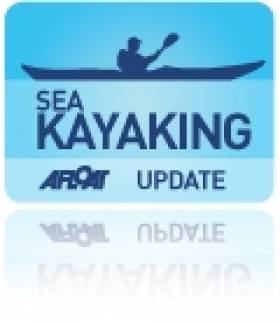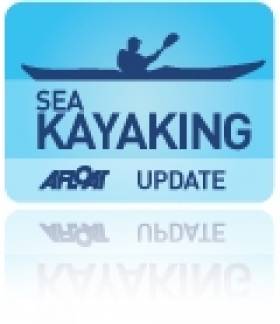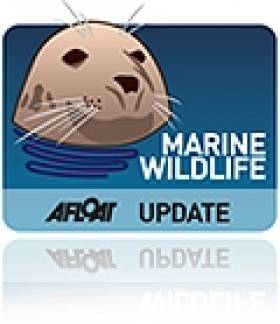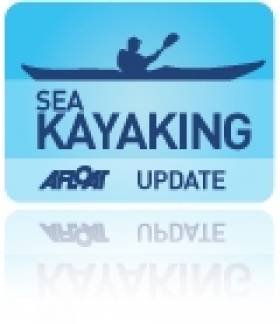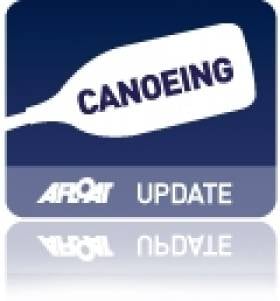Displaying items by tag: Kayaking
Kayak Splits In Two In Liffey Descent Incident
#LiffeyDescent - The Irish Mirror has posted footage of a daring rescue of two kayakers stranded after their tandem canoe crashed into a bridge support during the recent Liffey Descent.
The incident occurred at Leixlip bridge on the Dublin/Kildare border during the annual canoe and kayak race on Saturday 26 September.
In the video, British kayakers Sam Weller and Steven Bush can clearly be seen fighting against the fast current after their boat crashes into the bridge and splits in two.
But volunteers from Dublin Scouts immediately raced into action from the bridge overhead, abseiling down to the water to ensure the men's safety.
Bush confirmed that their brush with danger "hasn't put us off kayaking and we can't wait to come back next year and hopefully complete the race."
Neil Fleming and Robin Koenders's K2 was the fastest vessel home at this year's Liffey Descent, the 56th running of the canoe and kayak race, as previously reported on Afloat.ie.
Enniskillen Lifeboat Rescues Two After Kayak Capsize
#RNLI - Enniskillen RNLI rescued two people on Sunday evening (27 September) after a kayak was reported to have capsized at the mouth of the Colebrook River.
The volunteer lifeboat crew based on Upper Lough Erne at Carrybridge were requested by Belfast Coastguard to launch both their inshore lifeboat and rescue water craft (RWC) at 5.52pm.
The man and woman who came off the kayak had managed to swim ashore, raise the alarm using their mobile phone and let the coastguard know they were on an island.
The inshore lifeboat, helmed by Chris Cathcart, launched immediately along with the RWC. Weather conditions at the time were described as good with light airs and good visibility.
Following a search, the lifeboat crew located the casualties on the northern side of Inishcorkish Island. They were both cold and the woman was shaking and showing signs of hypothermia.
The crew immediately transferred both people to the lifeboat and began to administer casualty care. They were then brought to the shore at Knockninny Marina where they were medically assessed and made comfortable. The RWC then recovered the vessel back to Knockninny Marina.
Speaking following the callout, Enniskillen RNLI helm Chris Cathcart said: "The water was cold yesterday and the casualties had been in the lough for about 15 minutes during their swim to the island.
"They had prepared for their trip by carrying a means of communication and thankfully they were able to raise the alarm using their mobile phone. We wish them both a speedy recovery from their ordeal."
As reported on Afloat.ie earlier today, HM Coastguard is co-ordinating an ongoing search for an overdue sea kayaker off Portmuck in Co Antrim, concentrating on the area around the Gobbins coastal path.
New Round-Ireland Kayaking Record In The Offing
#Kayaking - It hasn't been the best summer for long-distance kayaking in Ireland, what with Manx duo Keirron Tastagh and George Shaw being forced to abandon their round-Ireland effort three weeks ago.
And that's not to mention exhaustion getting the better of pizza-oven maker Hendrik Lepel on the first leg of his voyage from Kinsale to Germany.
But two expeditions currently under way may have better chances as the weather improves.
The42.ie brings news of Jon Hynes and Sean Cahill's "once in a lifetime" kayaking trip round Ireland, which began on 16 June near the former's Kinsale home.
Taking a clockwise route around the island of Ireland, as of yesterday (Tuesday 30 June) the pair were taking shelter in Broadhaven Bay, Co Mayo awaiting a break in the weather to proceed to Donegal and on to the north coast and the half-way mark.
“It's definitely the pinnacle of expedition kayaking when you’re trying to get around Ireland in this type of weather!" said Hynes, who can boast of some 60 years of kayaking experience between him and Cahill.
However, ahead of them is an even more elite kayaker in the form of Waterford man Mick O'Meara, who as of yesterday was just four days shy of setting a brand new speed record for a solo circumnavigation of Ireland, as The Irish Times reports.
If O'Meara - a multiple-time Liffey Descent winner – reaches his hometown of Tramore by this Friday 3 July, he will have shaven two days off the record set by Jeff Allen and Harry Whelan on the 1,200km voyage in 2011.
Exhaustion Takes Toll On German Kayaker Off Cornwall
#Kayaking - Just days after embarking on an ambitious kayaking expedition from Kinsale to Germany, pizza oven company boss Hendrik Lepel was picked up by the RNLI after calling for help off Cornwall.
Padstow's volunteer lifeboat launched around 12am in the early hours of yesterday morning (Thursday 25 June) to rescue the German kayaker, who was suffering from fatigue after 30 hours at sea and unsure how to reach Padstow Harbour.
Quickly locating the four-metre kayak The Flying Northman, which was set up with an outrigger and sails, the crew took the tired casualty onboard and towed the kayak into Padstow where his support crew were waiting.
"It was a beautifully calm and flat night, with very light winds," said deputy second coxswain and mechanic Michael England. "The chap had been at sea for 30 hours and was extremely tired.
"Although he was also equipped with an outboard engine, he’d used the fuel and under sail it would have been a long passage into Padstow. Unfamiliar with the area, he was also unsure of the best way into the harbour.
"He did exactly the right thing to call for help, and although it was a late night for the crew, we didn’t get back to the station until 2.20am, we were happy to help him out."
Here's hoping Lepel – who admitted earlier to "not being experienced" at offshore kayaking – can resume his journey to Rostock in time to meet the tall ships without further incident!
#Kayaking - A German entrepreneur living in Cork is making his way home to meet the Tall Ships festival in an unique manner, as the Irish Examiner reports.
While Belfast Lough prepares to welcome the start of the Tall Ships Races next week, Hendrik Lepel is kayaking from Kinsale to his hometown of Rostock – via St George's Channel and around the English coast to Calais and onwards past the Low Countries to northern Germany and the Kiel Canal – in time to meet the tall ships after their race concludes in Denmark in mid August.
Despite "not being experienced" at offshore kayaking, Lepel left Kinsale on Saturday 20 June well prepared for nearly two months at sea, with the right provisions, safety and communications gear.
“I will stop every night when I can and get on to land, where possible," he said. "I can also put the kayak under sail if I need to."
Lepel, who runs a business manufacturing pizza ovens, will be padding in The Flying Northman, a sophisticated vessel that's more like a trimaran than a traditional kayak.
The Irish Examiner has more on the story HERE.
Kayakers Land Tope Shark For A Snap Off Inishowen
#MarineWildlife - A group of sea anglers off Donegal's Inishowen Peninsula got more than most would bargain for last week when they landed a shark – with video to prove it.
But far from fearful at the prospect, Graham Smith and friends told the Irish Examiner that they actively seek out such fishy predators as the tope shark, a few of which they caught while out kayaking in recent days.
"They normally range from 20lb to 45lb," he said of the small fighters, "but there are bigger ones around later in the year."
It's all in good sport, however, as the vulnerable species – also known as the school shark or snapper shark – were returned to the water "to terrorise the small fish of Inishowen."
#Kayaking - A duo of paddlers from the Isle of Man are getting ready to set a new round-Ireland sea kayaking record.
As BBC News reports, Keirron Tastagh and George Shaw aim to cover as many as 50 nautical miles a day in their standard seagoing kayaks to break the current 28-day record and raise funds for the RNLI.
And they've warmed up for the challenge appropriately, kayaking from their home in the Irish Sea to Northern Ireland as the start of their clockwise circumnavigation, beginning at Strangford in Co Down.
Experienced kayakers Tastagh and Shaw are already record breakers, after setting the furthest paddle west from Dutch Harbour – famous from the TV series Dangerous Catch – to Herbert Island in the Aleutians.
They're also not the first to attempt a circumnavigation this summer, as the Ogden brothers will set off from Baltimore over the June bank holiday in their 18ft Drascombe Lugger.
BBC News has more on the story HERE.
Seven Kayakers Rescued After Bristol Channel Ordeal
#Rescue - Just days after a kayaker was rescued from the Bristol Channel comes footage of another rescue on the opposite side of that same body of water – this time of seven people kayaking off the Exmoor coast.
According to the Western Morning News, Minehead RNLI's Atlantic lifeboat launched on Sunday (3 May) to the kayakers who got into difficulty off the Foreland Point lighthouse but were able to reach the safety of the shore.
One of the kayakers had suffered an injured ankle, and all were transferred by lifeboats from Minehead and Ilfracombe to nearby Lynnmouth Harbour for treatment.
Kayaker Rescued From Bristol Channel
#Rescue - A man was rescued from the water in the Bristol Channel off the Vale of Glamorgan this afternoon (Friday 1 May) after his kayak capsized and sank.
Milford Haven Coastguard Operations Centre received multiple emergency calls at 12:26pm from concerned members of the public who could see two kayakers, one of whom was in the water.
The remaining kayaker was attempting to tow the man in the water back to shore but appeared to be having difficulties.
Milford Haven Coastguard sent the Porthcawl RNLI lifeboat and the Porthcawl Coastguard Search and Rescue Team to the scene.
While the lifeboat was on its way, further reports came in telling the coastguard that the man was on longer being towed to shore but was holding onto an oar and drifting eastwards into the Bristol Channel. Onlookers had lost sight of him.
The coastguard tasked the second Porthcawl RNLI lifeboat, Barry Dock RNLI Lifeboat, RAF Chivenor search and rescue helicopter R619 and the Llantwit Major Coastguard Search and Rescue Team.
Meanwhile, the coastguard received a new 999 call from a member of the public who could see the man adrift, and were able to direct one of the Porthcawl lifeboats to the man’s location.
The man was conscious but very cold, and was winched from the lifeboat by the helicopter and taken to Morriston Hospital in Swansea.
“We were very relieved that the lifeboat was able to find the man in the water," said Johnathan Lewis of Milford Haven Coastguard.
"If you are going kayaking, always wear a buoyancy aid. Take at least a couple of means of calling for help with you. A VHF radio is ideal, backed up by mini marine flares and a mobile phone sealed inside a plastic bag."
Irish Student Dies On Slovenia Canoeing Trip
#Canoeing - The death of an Irish student on a canoeing trip in Slovenia is the second tragedy to befall a north Dublin college's adventure sports management course, as The Irish Times reports.
The young man, who has not yet been named, was canoeing on the Soca river as part of an official trip to Slovenia organised by Coláiste Dhulaigh in Coolock.
It's reported that the "accomplished and experienced" canoeist was paddling through a stretch of whitewater when his arm got stuck in the rocks.
Despite the best efforts of his fellow students to rescue and revive him, he was pronounced dead shortly after.
The incident comes five months after another student on the same course, 21-year-old Shane Murphy from Baldoyle, lost his life while kayaking with friends on the swollen River Inchavore.
The Irish Times has more on the story HERE.



























